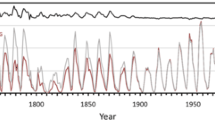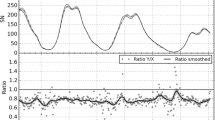Abstract
Empirical rules of solar-cycle evolution form important observational constraints for the solar-dynamo theory. This includes the Waldmeier rule relating the magnitude of a solar cycle to the length of its ascending phase, and the Gnevyshev–Ohl rule clustering cycles to pairs of an even-numbered cycle followed by a stronger odd-numbered cycle. These rules were established as based on the “classical” Wolf sunspot number series, which has been essentially revisited recently, with several revised sets released by the research community. Here we test the robustness of these empirical rules for different sunspot (group) series for the period 1749 – 1996, using four classical and revised international sunspot-number and group sunspot-number series. We also provide an update of the sunspot-group series based on the active-day fraction (ADF) method, using the new database of solar observations. We show that the Waldmeier rule is robust and independent of the exact sunspot (group) series: its classical and \(n+1\) (relating the length of \(n\)th cycle to the magnitude of (\(n+1\))th cycle) formulations are significant or highly significant for all series, while its simplified formulation (relating the magnitude of a cycle to its full length) is insignificant for all series. The Gnevyshev–Ohl rule was found robust for all analyzed series for Solar Cycles 8 – 21, but unstable across the Dalton minimum and before it.




Similar content being viewed by others
References
Aparicio, A.J.P., Vaquero, J.M., Cruz Gallego, M.: 2012, The proposed “Waldmeier discontinuity”: How does it affect to sunspot cycle characteristics? J. Space Weather Space Clim. 2, A12. DOI. ADS.
Arlt, R., Vaquero, J.M.: 2020, Historical sunspot records. Liv. Rev. Solar Phys. 17, 1. DOI. ADS.
Arlt, R., Leussu, R., Giese, N., Mursula, K., Usoskin, I.G.: 2013, Sunspot positions and sizes for 1825-1867 from the observations by Samuel Heinrich Schwabe. Mon. Not. Roy. Astron. Soc. 433, 3165. DOI.
Carrasco, V.M.S., Aparicio, A.J.P., Vaquero, J.M., Gallego, M.C.: 2016, The new sunspot-number index and solar-cycle characteristics. Solar Phys. 291, 3045. DOI. ADS.
Carrasco, V.M.S., Gallego, M.C., Arlt, R., Vaquero, J.M.: 2020, Revisiting the amplitude of solar cycle 9: The case of sunspot observations by W.C. Bond. Solar Phys. 295, 127. DOI. ADS.
Charbonneau, P.: 2020, Dynamo models of the solar cycle. Liv. Rev. Solar Phys. 17, 4. DOI. ADS.
Charbonneau, P., Dikpati, M.: 2000, Stochastic fluctuations in a Babcock–Leighton model of the solar cycle. Astrophys. J. 543, 1027. DOI. ADS.
Chatzistergos, T., Usoskin, I.G., Kovaltsov, G.A., Krivova, N.A., Solanki, S.K.: 2017, New reconstruction of the sunspot group numbers since 1739 using direct calibration and “backbone” methods. Astron. Astrophys. 602, A69. DOI. ADS.
Clette, F., Lefèvre, L.: 2016, The new sunspot number: Assembling all corrections. Solar Phys. 291, 2629. DOI. ADS.
Clette, F., Berghmans, D., Vanlommel, P., Van der Linden, R.A.M., Koeckelenbergh, A., Wauters, L.: 2007, From the Wolf number to the International Sunspot Index: 25 years of SIDC. Adv. Space Res. 40, 919. DOI. ADS.
Clette, F., Svalgaard, L., Vaquero, J.M., Cliver, E.W.: 2014, Revisiting the sunspot number: A 400-year perspective on the solar cycle. Space Sci. Rev. 186, 35. DOI.
Cliver, E.W., Ling, A.G.: 2016, The discontinuity circa 1885 in the group sunspot number. Solar Phys. 291, 2763. DOI. ADS.
Eddy, J.A.: 1976, The maunder minimum. Science 192, 1189. DOI. ADS.
Gnevyshev, M.N., Ohl, A.I.: 1948, On the 22-year cycle of solar activity. Astron. Zh. 25, 18.
Hathaway, D.H.: 2015, The solar cycle. Liv. Rev. Solar Phys. 12, 4. DOI.
Hathaway, D.H., Wilson, R.M., Reichmann, E.J.: 2002, Group sunspot numbers: Sunspot cycle characteristics. Solar Phys. 211, 357.
Hayakawa, H., Besser, B.P., Iju, T., Arlt, R., Uneme, S., Imada, S., Bourdin, P.-A., Kraml, A.: 2020, Thaddäus Derfflinger’s sunspot observations during 1802-1824: A primary reference to understand the dalton minimum. Astrophys. J. 890, 98. DOI. ADS.
Hoyt, D.V., Schatten, K.H.: 1998, Group sunspot numbers: A new solar activity reconstruction. Solar Phys. 179, 189. DOI. ADS.
Komitov, B., Bonev, B.: 2001, Amplitude variations of the 11 year cycle and the current solar maximum 23. Astrophys. J. Lett. 554, L119. DOI. ADS.
Kremliovsky, M.N.: 1994, Can we understand time scales of solar activity? Solar Phys. 151, 351. ADS.
Lockwood, M., Owens, M.J., Barnard, L.: 2014, Centennial variations in sunspot number, open solar flux, and streamer belt width: 1. Correction of the sunspot number record since 1874. J. Geophys. Res. 119, 5172. DOI. ADS.
Lockwood, M., Owens, M.J., Barnard, L.A., Scott, C.J., Watt, C.E., Bentley, S.: 2018, Space climate and space weather over the past 400 years: 2. Proxy indicators of geomagnetic storm and substorm occurrence. J. Space Weather Space Clim. 8, A12. DOI. ADS.
Muñoz-Jaramillo, A., Vaquero, J.: 2019, Visualization of the challenges and limitations of the long-term sunspot number record. Nature Astron. 3, 205. DOI. ADS.
Mursula, K., Usoskin, I.G., Kovaltsov, G.A.: 2001, Persistent 22-year cycle in sunspot activity: Evidence for a relic solar magnetic field. Solar Phys. 198, 51. DOI. ADS.
Solanki, S.K., Krivova, N.A., Schüssler, M., Fligge, M.: 2002, Search for a relationship between solar cycle amplitude and length. Astron. Astrophys. 396, 1029. DOI.
Solanki, S.K., Usoskin, I.G., Kromer, B., Schüssler, M., Beer, J.: 2004, Unusual activity of the Sun during recent decades compared to the previous 11,000 years. Nature 431, 1084. DOI. ADS.
Svalgaard, L., Schatten, K.H.: 2016, Reconstruction of the sunspot group number: The backbone method. Solar Phys. 291, 2653. DOI. ADS.
Takalo, J., Mursula, K.: 2018, Principal component analysis of sunspot cycle shape. Astron. Astrophys. 620, 100. DOI. ADS.
Tlatov, A.G.: 2013, Reversals of Gnevyshev–Ohl rule. Astrophys. J. Lett. 772, L30. DOI. ADS.
Usoskin, I.G.: 2017, A history of solar activity over millennia. Liv. Rev. Solar Phys. 14, 3. DOI.
Usoskin, I.G., Mursula, K.: 2003, Long-term solar cycle evolution: Review of recent developments. Solar Phys. 218, 319.
Usoskin, I.G., Mursula, K., Kovaltsov, G.A.: 2001, Was one sunspot cycle lost in late xviii century? Astron. Astrophys. 370, L31. DOI.
Usoskin, I.G., Mursula, K., Kovaltsov, G.A.: 2002, Lost sunspot cycle in the beginning of dalton minimum: New evidence and consequences. Geophys. Res. Lett. 29, 36. ADS.
Usoskin, I.G., Mursula, K., Arlt, R., Kovaltsov, G.A.: 2009, A solar cycle lost in 1793-1800: Early sunspot observations resolve the old mystery. Astrophys. J. Lett. 700, L154. DOI. ADS.
Usoskin, I.G., Arlt, R., Asvestari, E., Hawkins, E., Käpylä, M., Kovaltsov, G.A., Krivova, N., Lockwood, M., Mursula, K., O’Reilly, J., Owens, M., Scott, C.J., Sokoloff, D.D., Solanki, S.K., Soon, W., Vaquero, J.M.: 2015, The Maunder minimum (1645-1715) was indeed a grand minimum: A reassessment of multiple datasets. Astron. Astrophys. 581, A95. DOI. ADS.
Usoskin, I.G., Kovaltsov, G.A., Lockwood, M., Mursula, K., Owens, M., Solanki, S.K.: 2016, A new calibrated sunspot group series since 1749: Statistics of active day fractions. Solar Phys. 291, 2685. DOI. ADS.
Vaquero, J.M.: 2007, Historical sunspot observations: A review. Adv. Space Res. 40, 929. DOI. ADS.
Vaquero, J.M., Svalgaard, L., Carrasco, V.M.S., Clette, F., Lefèvre, L., Gallego, M.C., Arlt, R., Aparicio, A.J.P., Richard, J., Howe, R.: 2016, A revised collection of sunspot group numbers. Solar Phys. 291, 3061. DOI.
Vitinsky, Y.I., Kopecky, M., Kuklin, G.V.: 1986, Statistics of Sunspot Activity, Nauka, Moscow (in Russian).
Waldmeier, M.: 1935, Neue Eigenschaften der Sonnenflecken Kurve. Astron. Mitt. Eidgenöss. Sternwarte Zür. 14, 105. ADS.
Waldmeier, M.: 1939, Die Zonenwanderung der Sonnenflecken. Astron. Mitt. Eidgenöss. Sternwarte Zür. 14, 470. ADS.
Willamo, T., Usoskin, I.G., Kovaltsov, G.A.: 2017, Updated sunspot group number reconstruction for 1749-1996 using the active day fraction method. Astron. Astrophys. 601, A109. DOI. ADS.
Willamo, T., Usoskin, I.G., Kovaltsov, G.A.: 2018, A test of the active-day fraction method of sunspot group number calibration: Dependence on the level of solar activity. Solar Phys. 293, 69. DOI. ADS.
Acknowledgments
This work was partially supported by the Academy of Finland (project No. 321882 ESPERA) and by the Russian Science Foundation (RSF project No. 20-67-46016). The authors benefited from discussions within the ISSI International Team work #417 (Recalibration of the Sunspot Number Series) and ISWAT-COSPAR S1-01 team.
Author information
Authors and Affiliations
Corresponding author
Ethics declarations
Disclosure of Potential Conflicts of Interest
The authors declare that they have no conflicts of interest.
Additional information
Publisher’s Note
Springer Nature remains neutral with regard to jurisdictional claims in published maps and institutional affiliations.
Supplementary Information
Appendix: Update of the Sunspot Group Numbers Using the ADF Method
Appendix: Update of the Sunspot Group Numbers Using the ADF Method
The active-day fraction (ADF) method of the sunspot (group) number reconstruction was invented by Usoskin et al. (2016) and greatly upgraded by Willamo, Usoskin, and Kovaltsov (2017). It is based on the assumption that the “quality” of a solar observer is entirely defined by their observational threshold, rather than a scaling factor used in other methods. An important advantage of the ADF method is that it calibrates the observers directly to the reference series avoiding the daisy-chain calibration intrinsic to other methods. As a drawback, the ADF method tends to strongly overestimate the low-activity and moderately underestimate the high-activity cycles (Willamo, Usoskin, and Kovaltsov, 2018).
After the publication of the ADF-based reconstruction by Willamo, Usoskin, and Kovaltsov (2017), based on the sunspot-group observation database of Hoyt and Schatten (1998), an essential update was made with the upgrade and systematization of all known sunspot records, as collected in a database of Vaquero et al. (2016). Accordingly, we have revisited the ADF-based sunspot-group number reconstructed here, following exactly the algorithm described by Willamo, Usoskin, and Kovaltsov (2017), but using the new sunspot-number database (Vaquero et al., 2016). As the reference observer, we used the Royal Greenwich Observatory (solarscience.msfc.nasa.gov/greenwch.shtml), similarly to Willamo, Usoskin, and Kovaltsov (2017).
The resultant data-series for the period of 1749 – 1996 is shown in Figure 5a and tabulated in the Supplementary Information as monthly and annual sunspot-group series. The ratio of the (annual) series obtained here to that of Willamo, Usoskin, and Kovaltsov (2017) is shown in Figure 5b. It is kept close (within 10%) of unity after 1880, with small deviations being related to the Monte-Carlo procedure of the observers’ calibration. The ratio can, however, vary by up to 40% before the Dalton minimum. On the other hand, the ratio is consistent with unity within the error bars.
a) Monthly sunspot-group number reconstructed here using the ADF method and the updated solar-observation database (Vaquero et al., 2016). Uncertainties (\(\pm 1\sigma \)) are shown in gray. Tabulated values are provided in the Supplementary Information. b) Ratio of the annual values of the SGN obtained here to those from Willamo, Usoskin, and Kovaltsov (2017). The unity value is shown by the dashed line. The ratio values are not shown for the periods around solar-cycle minima (SNG<1).
This series supersedes the previous ADF-based SGN (Usoskin et al., 2016; Willamo, Usoskin, and Kovaltsov, 2017) and is used here for further analysis.
Rights and permissions
About this article
Cite this article
Usoskin, I., Kovaltsov, G. & Kiviaho, W. Robustness of Solar-Cycle Empirical Rules Across Different Series Including an Updated Active-Day Fraction (ADF) Sunspot Group Series. Sol Phys 296, 13 (2021). https://doi.org/10.1007/s11207-020-01750-9
Received:
Accepted:
Published:
DOI: https://doi.org/10.1007/s11207-020-01750-9





